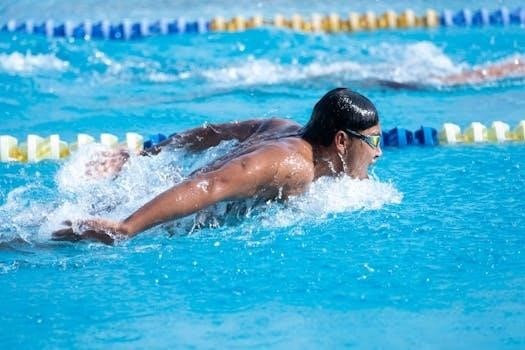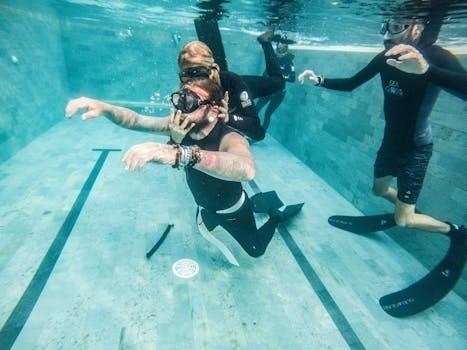flowclear pool pump instructions
Flowclear Pool Pump Instructions⁚ A Comprehensive Guide
Welcome! This guide provides comprehensive instructions for your Flowclear pool pump, ensuring clean, clear, and hygienic water․ We cover setup, operation, maintenance, troubleshooting, safety, and finding replacement parts, helping you maintain your pool effectively․
Flowclear pool pumps, commonly used for above-ground pools, are designed for circulating and filtering water, keeping it clean and free of debris․ These pumps effectively remove impurities, maintaining water hygiene, which is crucial for swimmer health and prolonging pool life․ Regular filtration, ideally a minimum of eight hours daily, ensures clear water․ Proper usage and maintenance, including cleaning filter cartridges and addressing issues like low flow or leaks, are essential․ Always prioritize safety by following electrical guidelines and storing pumps correctly during the off-season․ This guide provides comprehensive instructions for optimal performance and longevity of your Flowclear pump․

Understanding Your Flowclear Pump Model
Identifying your Flowclear pump model is crucial․ Knowing your model number unlocks specific details about features, specifications, and compatible replacement parts, ensuring proper maintenance and optimal performance․
Identifying Your Specific Model Number
Locating your Flowclear pump’s model number is the first step toward effective maintenance and troubleshooting․ This number provides access to specific information regarding your pump’s specifications, compatible parts, and troubleshooting guides․ Typically, the model number is found on a sticker affixed directly to the pump housing․ Look for a series of numbers and letters, often near the power cord or on the pump’s side․
The label might also include the pump’s voltage and amperage․ Once you’ve located the model number, record it for future reference․ This will be invaluable when searching for replacement parts, consulting the user manual, or seeking support from the manufacturer․ Keep this information handy to ensure compatibility and proper functioning of your Flowclear pool pump․ Correct identification is vital for optimal pool maintenance․
Key Features and Specifications
Understanding your Flowclear pump’s key features and specifications is essential for optimal pool maintenance․ Common features include flow rate, measured in gallons or liters per hour, indicating the pump’s water circulation capacity․ Filtration type, whether cartridge or sand filter, determines the water purification method․ The pump’s motor power, expressed in horsepower or wattage, affects its efficiency and performance․
Timer settings, available on some models, allow for automated filtration cycles․ Safety features, such as GFCI plugs, protect against electrical hazards․ Pool compatibility specifies the appropriate pool size and capacity․ Knowing these specifications helps you choose the right pump settings and maintain your pool effectively․ Consult your model’s manual for precise details, ensuring proper operation and longevity․ This knowledge empowers you to optimize water clarity and hygiene․

Initial Setup and Installation
Proper setup is crucial․ This section details unboxing, parts verification, connecting the pump to your pool, and priming․ Follow these steps carefully for optimal performance and to avoid potential issues․
Unboxing and Parts Verification
Upon receiving your Flowclear pump, carefully unbox all components․ Verify that all listed parts are present, referencing the included installation manual․ Typically, this includes the pump unit, filter cartridge (or sand, depending on the model), hoses, clamps, and any necessary adaptors or connectors․ Inspect each component for any shipping damage․
Pay close attention to the GFCI plug if equipped, ensuring it is intact․ Check the filter cartridge for tears or deformities․ If any parts are missing or damaged, contact the retailer or manufacturer for assistance before proceeding with installation․ Proper verification ensures a smooth setup․
Connecting the Pump to Your Pool
Connecting your Flowclear pump involves attaching hoses to the pool’s inlet and outlet ports․ Ensure the pool is not in use․ Attach one hose from the pool’s outlet (where water exits the pool) to the pump’s inlet․ Securely fasten using clamps․ Connect the second hose from the pump’s outlet (where filtered water returns) to the pool’s inlet․
Double-check that all connections are tight to prevent leaks․ Make sure the pump is vertically fixed on the ground․ Position the pump on a level surface near a GFCI-protected electrical outlet․ Avoid placing the pump in direct sunlight․
Priming the Pump
Priming your Flowclear pump is essential to remove air from the system before operation․ Begin by ensuring the pump is properly connected to the pool and the hoses are secure․ Open the air purge valve or bleeder valve on top of the pump housing to release trapped air․
Slowly pour water into the pump housing until it’s full and water starts to come out of the purge valve․ Close the purge valve tightly․ Now, plug the pump into a GFCI-protected outlet․ Monitor the pump for proper water flow․ Repeat if necessary to ensure all air is removed․
Operating Instructions
This section explains how to operate your Flowclear pump․ Learn to turn it on/off, set timers, and understand flow rates․ Proper operation ensures optimal filtration and clean pool water, maintaining hygiene․
Turning the Pump On and Off
Before initiating the pump, ensure it is properly connected to the power source and the pool․ Verify all connections are secure to prevent leaks․ To turn the pump on, locate the power switch, typically found on the pump’s housing; Ensure your hands are dry before touching any electrical components․ Flip the switch to the “on” position․ You should hear the motor start and see water circulating․
To turn the pump off, simply flip the power switch to the “off” position․ Always turn off the pump before performing any maintenance or adjustments․ Disconnecting the power cord is also advisable for added safety․ Regularly inspect the power cord for damage․ If you observe any issues, replace the cord immediately to avoid electrical hazards․
Setting the Timer (if applicable)
Some Flowclear pump models come equipped with a built-in timer for automated operation․ To set the timer, first locate the timer control panel on the pump․ This panel may feature buttons, dials, or a digital display․ Consult your specific model’s manual for detailed instructions on accessing the timer settings․
Once in the timer settings, you can typically define the start and stop times for the pump’s operation․ This allows you to schedule filtration cycles according to your pool’s needs․ For example, you might set the pump to run for 8 hours daily, filtering the water during off-peak hours․ Ensure the timer settings are accurate to maintain optimal water clarity and hygiene․ Regularly check and adjust the timer as needed․
Understanding Flow Rates and Filtration Cycles
Flow rate, measured in gallons per hour (GPH) or liters per hour (LPH), indicates how quickly your Flowclear pump circulates water․ A higher flow rate means faster filtration․ Filtration cycles refer to the duration the pump runs daily to clean the entire pool volume․
To calculate the ideal cycle, determine your pool’s volume and divide it by the pump’s flow rate․ This gives you the time to filter the entire pool once․ Experts recommend filtering the water at least once daily, preferably twice, especially during peak swimming season․ Adjust the pump’s run time based on usage and environmental factors like debris․ Regular monitoring ensures clear, hygienic water․

Maintenance and Troubleshooting
Maintaining your Flowclear pump ensures optimal performance․ This section covers filter cleaning, backwashing (if applicable), and troubleshooting common issues like low flow or leaks, extending the lifespan of your pump․
Cleaning the Filter Cartridge
Regularly cleaning the filter cartridge is crucial for maintaining optimal water quality in your pool․ A dirty filter reduces flow rate and filtration effectiveness․ To clean, first, turn off and unplug the pump․ Then, remove the filter housing and carefully take out the cartridge․ Use a garden hose with a nozzle to spray the cartridge pleats, removing any accumulated debris, dirt, and algae․ For stubborn buildup, a soft brush may be used․ Avoid using soap or harsh chemicals, as they can damage the filter material and introduce unwanted substances into your pool water․ Rinse the cartridge thoroughly until the water runs clear․ Inspect the cartridge for any tears or damage; replace if necessary․ Once clean, reassemble the filter housing and restart the pump․ Cleaning frequency depends on pool usage and environmental factors, but typically, cleaning every two weeks is recommended for optimal performance․
Backwashing (for sand filter pumps)
Backwashing is essential for sand filter pumps to remove accumulated debris and maintain optimal filtration․ This process reverses the water flow, flushing out trapped particles․ To backwash, turn off the pump and set the multiport valve to the “backwash” position․ Connect a backwash hose to the waste outlet to direct dirty water away from your pool area․ Turn on the pump, allowing water to flow backward through the sand bed, lifting and removing debris․ Backwash until the water in the sight glass runs clear, typically two to three minutes․ Turn off the pump and set the multiport valve to “rinse” for about 30 seconds to resettle the sand bed․ Finally, turn off the pump again and return the multiport valve to the “filter” position for normal operation․ Regularly backwashing, usually weekly or when pressure gauge indicates, ensures efficient filtration and extends sand life․
Troubleshooting Common Issues (e․g․, low flow, leaks)
Addressing common issues promptly ensures optimal pump performance․ Low flow can result from a clogged filter cartridge or skimmer basket․ Clean these components regularly․ Check for obstructions in the pump impeller or inlet/outlet hoses․ Ensure all connections are tight to prevent air leaks, which can also reduce flow․ If the pump leaks, inspect O-rings and seals for damage; replace if necessary․ Verify hose clamps are secure and properly positioned․ Air in the system can cause the pump to lose prime; check water levels and ensure the pump is properly primed․ If the pump is noisy, inspect for debris in the impeller or motor bearings․ Persistent problems may require professional assistance from a qualified pool technician․ Regularly inspecting and maintaining your pump can prevent many common issues․

Safety Precautions
Prioritize safety when operating and maintaining your Flowclear pool pump․ Always disconnect the pump from the power source before any maintenance․ Follow electrical safety guidelines, and ensure proper storage during the off-season to prevent damage․
Electrical Safety Guidelines
Adhering to electrical safety guidelines is crucial when operating your Flowclear pool pump․ Always connect the pump to a Ground Fault Circuit Interrupter (GFCI) protected outlet to prevent electric shock․ Test the GFCI regularly by pressing the test button; it should interrupt power․ Ensure the pump is properly grounded․
Never use extension cords; plug the pump directly into the outlet․ Keep the pump away from water and moisture to avoid electrical hazards․ If the pump’s cord is damaged, it must be replaced by a qualified technician․ Disconnect the pump before maintenance or cleaning․
Do not operate the pump while people are in the pool․ Ensure all electrical connections are secure and protected from the elements․ Regularly inspect the pump and its components for any signs of damage․
Proper Storage During Off-Season
Proper storage of your Flowclear pool pump during the off-season is essential to prolong its lifespan and ensure optimal performance when you need it again․ Before storing, thoroughly clean the pump and filter cartridge to remove any debris or buildup; Allow all parts to dry completely to prevent mold and mildew growth․
Disconnect all hoses and drain any remaining water from the pump housing․ Store the pump in a dry, protected area, away from extreme temperatures and direct sunlight․ Ideally, store it in its original packaging or a sturdy container to prevent damage․
Inspect the pump for any signs of wear or damage before storing, and address any issues to prevent further deterioration․ Keep the pump and its components away from chemicals or sharp objects that could cause damage during storage․
Finding Replacement Parts and Accessories
Locating the correct replacement parts and accessories for your Flowclear pool pump is crucial for maintaining its efficiency and longevity․ Start by identifying your specific pump model number, usually found on a label on the pump housing․ With the model number, visit the Bestway website or authorized retailers to find compatible parts․
Common replacement parts include filter cartridges, hoses, seals, and impellers․ When purchasing, ensure the parts are genuine Flowclear products or approved alternatives to guarantee proper fit and performance․ Online marketplaces like Amazon and eBay also offer a wide selection of parts, but verify the seller’s reputation and product authenticity before buying․
Consider purchasing essential accessories like pool covers, cleaning tools, and water testing kits to complement your pump and maintain optimal pool hygiene․ Regularly inspect your pump and replace worn parts promptly to prevent further damage and ensure clean, clear pool water․